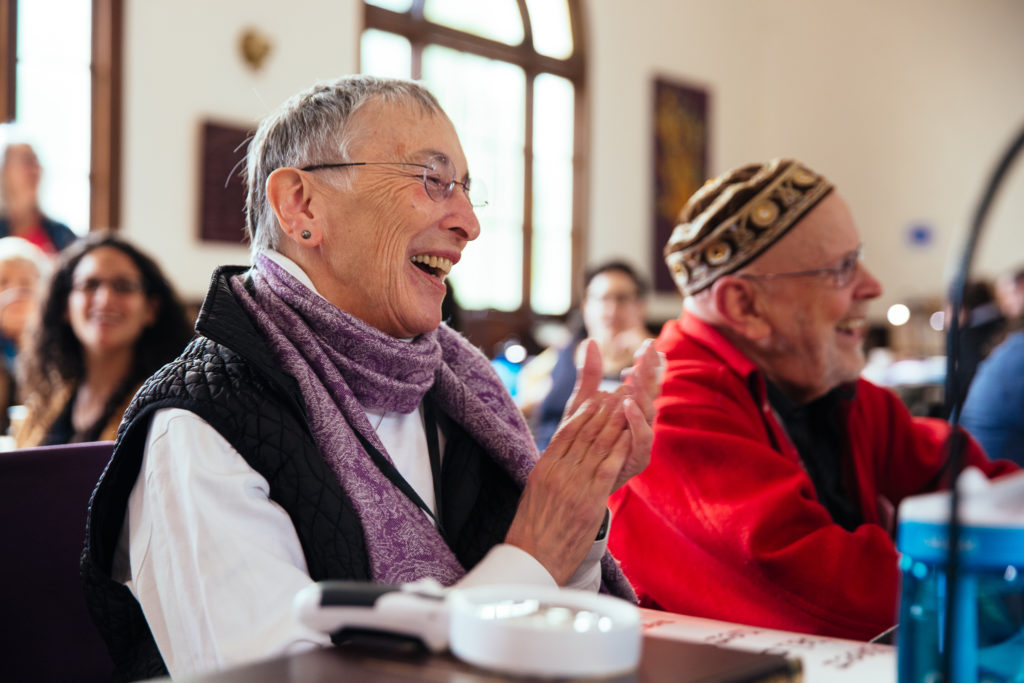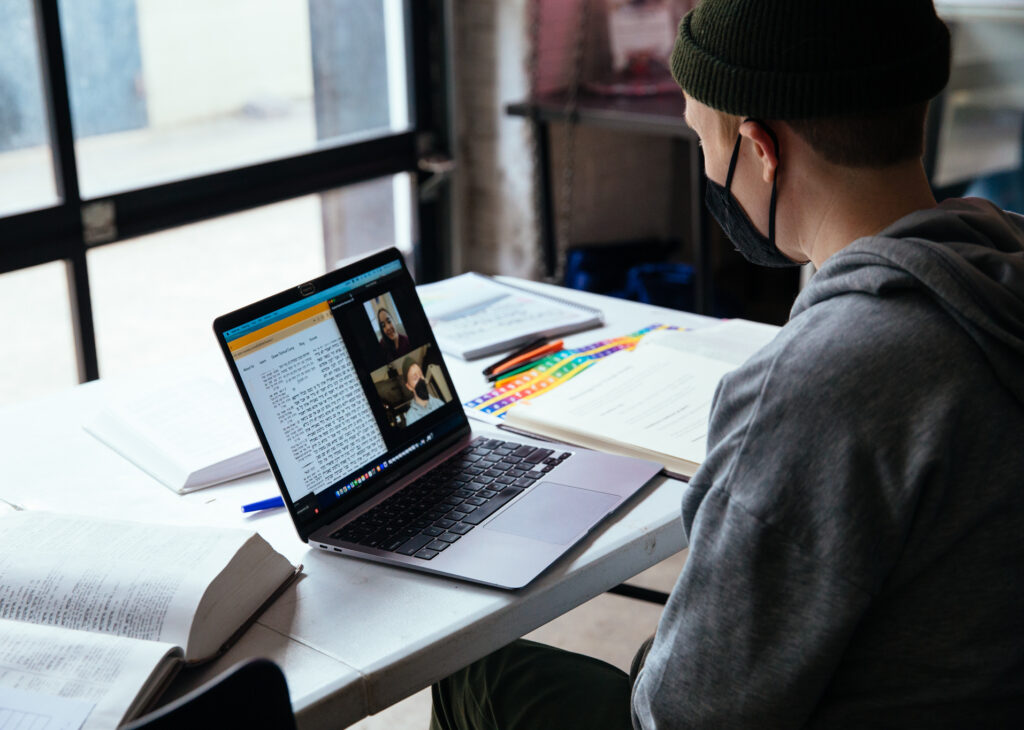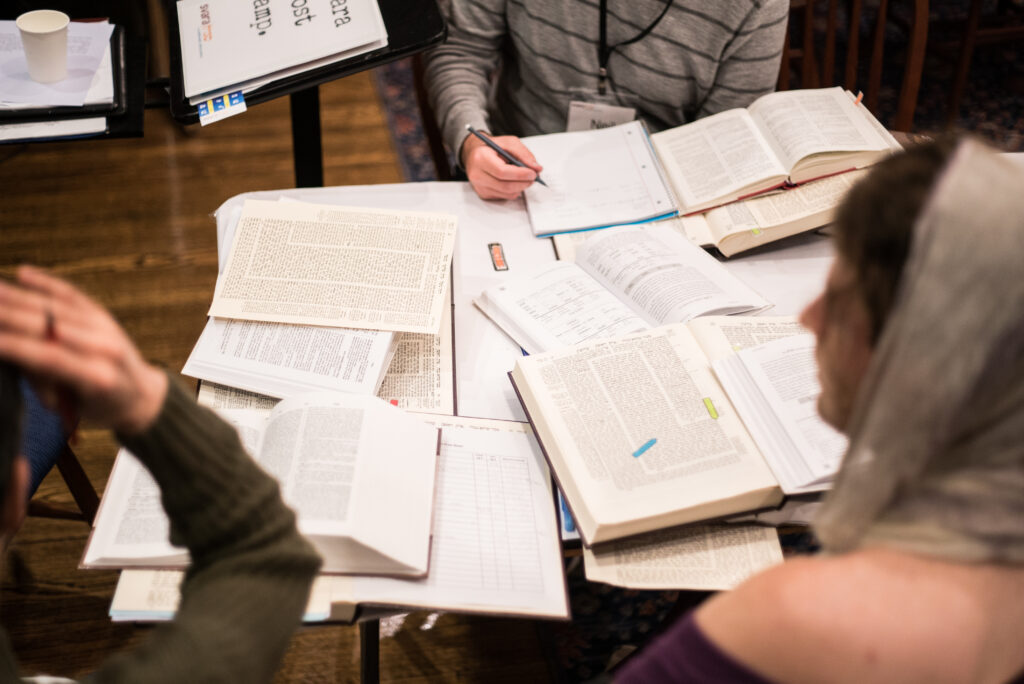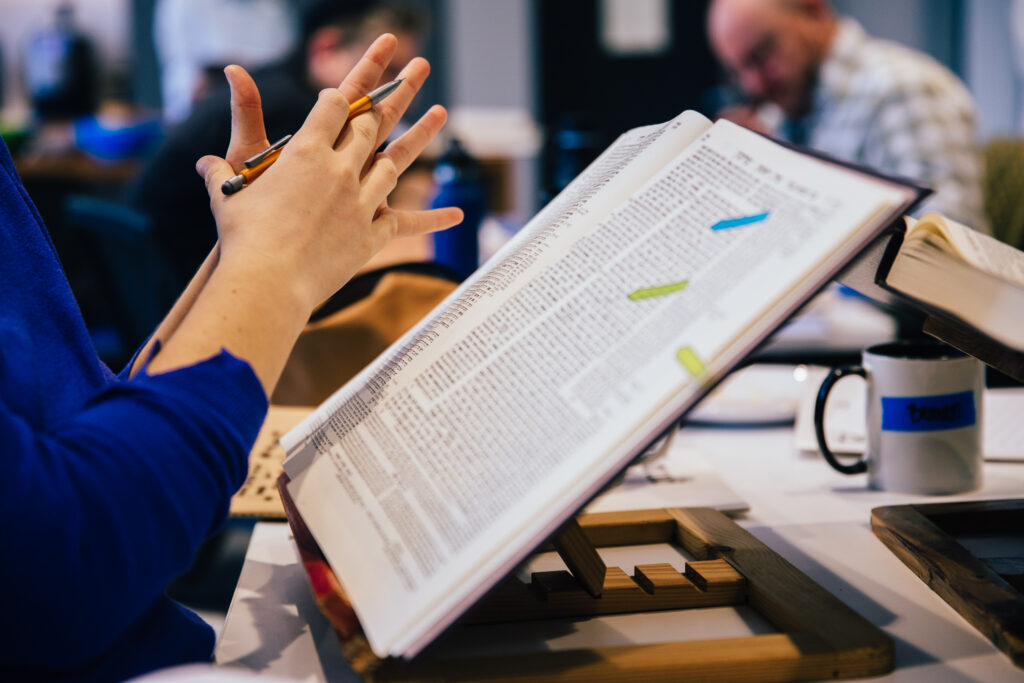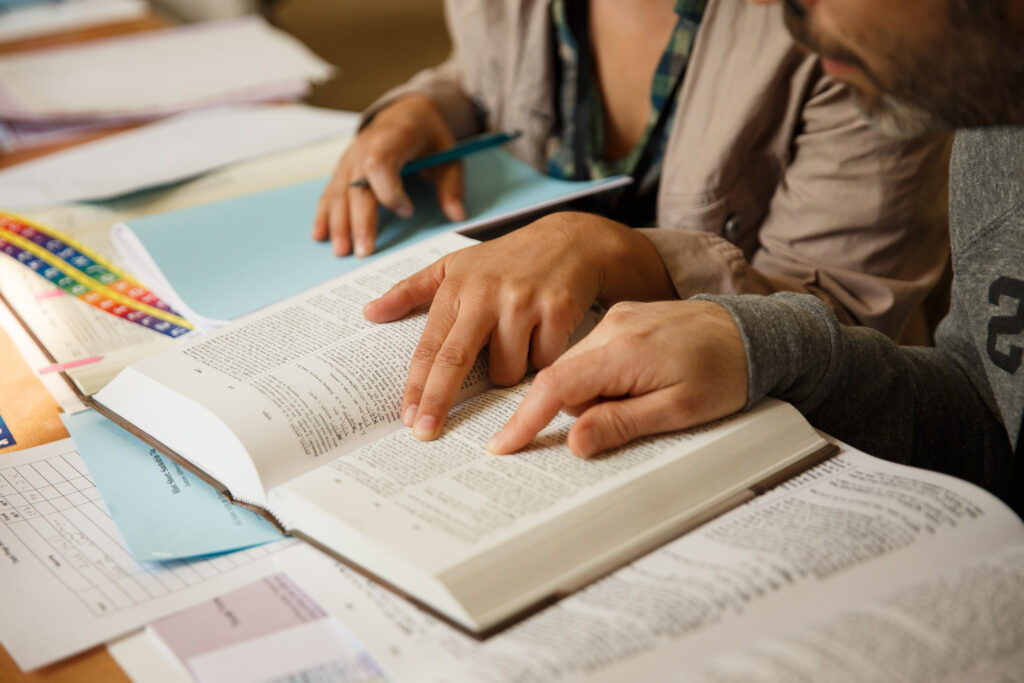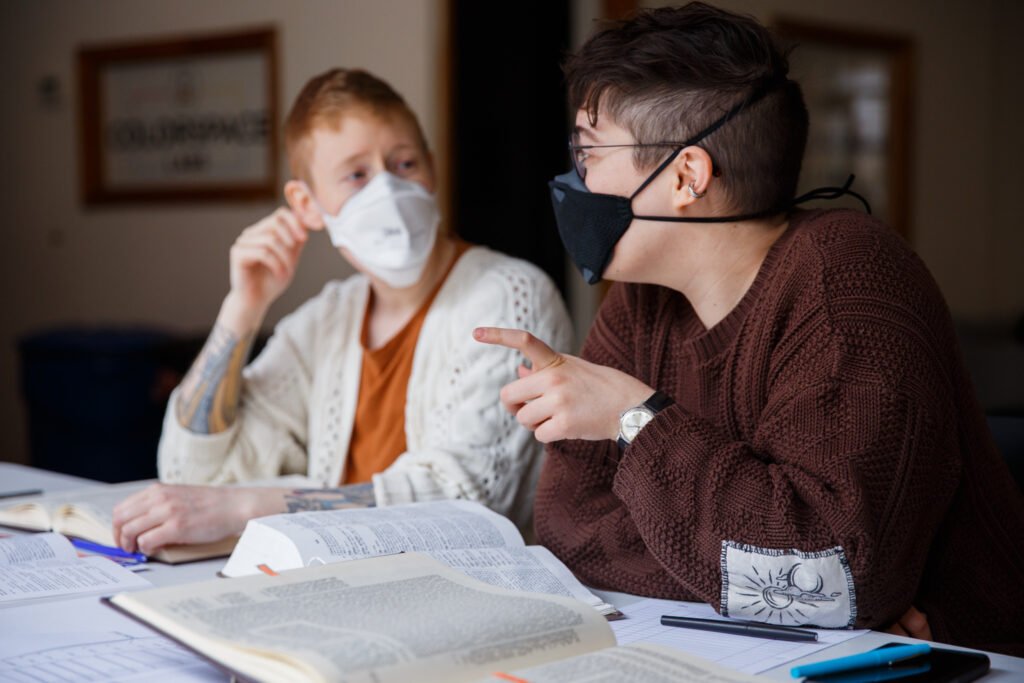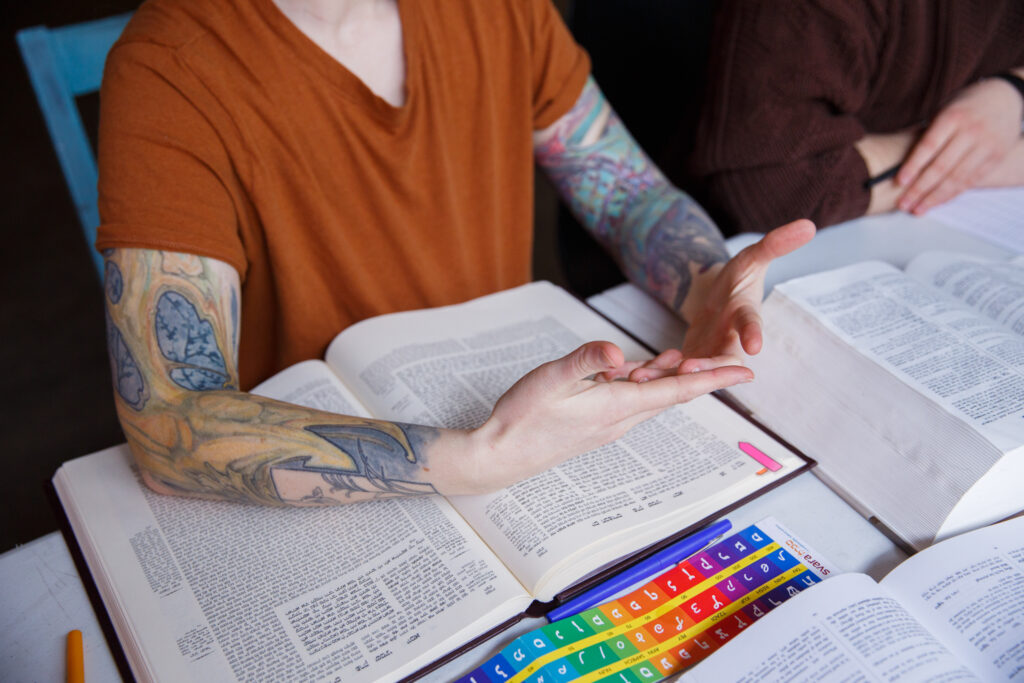I would have never made it through rabbinical school without my chevruta, Rabbi Emily Barton. Emily always knew how to call the rabbis out on their sh*t and how to make an obscure agricultural law seem incredibly interesting. She also made sure there were freshly-baked desserts to help us get through the night. We grew as learners together, but more than that, we grew as people together.
Anyone familiar with SVARA knows how much we value chevruta (חברותא), one of the greatest inheritances we’ve received from our queer rabbi ancestors. Chevruta is the method of learning in partnership, having a companion in the awesome and vulnerable journey of learning a new text (or a new skill within a text, or a single new word, or discovering the radical inside translation of a word you thought you knew but is now mind-blowingly strange and unfamiliar). Our ancestors knew in their svara (סברא intuitive moral kishkes קישקעס/guts) that we can only integrate so much newness on our own. It can be hard, if not impossible, to delve into the sacred act of learning in solitude. When we find ourselves alone in learning spaces, we often cling to previously held notions of ourselves and the world. Sometimes it’s an egoism informed by privilege and societal approval; other times it’s a lack of self-trust because of marginalization and oppression at the hands of “normative” society. For these reasons, it can be difficult for a person to learn alone because their sense of self-worth has been harmed in what should have been safe spaces for growth.
We’ve heard from many students at SVARA that they have had traumatic learning experiences (unfortunately this is also true for many of our faculty members, myself included). Many SVARA-niks have had teachers in the past who undervalued or humiliated them. Many SVARA-niks have felt that their access needs were never supported or even recognized. All of this contributes to why the chevruta relationship is central to the SVARA method.
Our queer rabbi ancestors also believed that chevruta was critically important. Today we continue in their tradition by staying aware of our complex relationship dynamics, and prioritizing a sensitivity to positionality. One of the ways we do this is by modeling the chevruta relationship as a place to make mistakes and invest deeply, even unapologetically, in our chevruta’s learning and growth as much as our own.
If you’ve taken a SVARA class before, you’ve most definitely seen this modeled in the chazarah (חזרה “review”) process. By reciting words of Mishnah and Gemara from memory, we are often at our most vulnerable. But what happens in chazarah is the practice of presence, witness, and accompaniment. What matters is that each member of the chevruta feels their partner present with them, witnessing both the wisdoms and hardships they have to share, and accompanying them on their own journey. This is why the interchange between chevrutot (plural of chevruta) have led to so many radical, reparative innovations in the Talmud—the effective elimination of capital punishment and the emphasis on restorative justice (Sanhedrin 17a); the recognition that verbal oppression is just as harmful as (and often interlaced with) monetary oppression (Bava Metzia 58b); and that a person is obligated to protest the injustices done in one’s home, one’s town, and even in the world at large (Shabbat 54b), just to name a few.
You’d be right to argue that our queer rabbi ancestors, and by implication us as their inheritors, have not always gone far enough in the transformative and healing potential of chevruta. The rabbis of the Talmud have certainly made colossal missteps, like impeding upon the rights and recognition of women and neurodiverse people. Today, it falls upon all of us to take responsibility for the shortcomings of our ancestors. It falls upon all of us to recognize and repair the harms done by racism, ableism, and transphobia in both global and personal memory. We do this work by engaging in chevruta: by practicing the vulnerability of being human in a harsh world, and strengthening each other every step of the way.
An example of the powerful vulnerability of chevruta can be can be found in Masechet Berakhot (P.S. we will be exploring Berakhot in Mishnah Collective beginning July 6th and it’s uhh-mazing!). Rav Pappa and Abaye are discussing a statement made by Rabbi Zeira that anyone who repeats the words of the Shema [having made an error with the words] is reprehensible. Rav Pappa argues that perhaps the first time this individual said the words of the Shema, he didn’t have kavanah (כונה intention), which, according to the Rabbis, is a requirement for the recitation of the Shema. Repeating the words a second time doesn’t happen only when someone makes an error; it happens when we recognize a need to recite them properly and with intention. Then Abaye has this most striking response—
חַבְרוּתָא כְּלַפֵּי שְׁמַיָּא מִי אִיכָּא?! אִי לָא כַּוֵּון דַּעְתֵּיהּ מֵעִיקָּרָא — מָחֵינַן לֵיהּ בְּמַרְזַפְתָּא דְנַפָּחָא עַד דִּמְכַוֵּין דַּעְתֵּיהּ.
Can one have a chevruta with Heaven? If he did not focus his attention initially, we beat him with a blacksmith’s hammer until he focuses his attention.
The discussion ends abruptly and moves on to another mishnah (משנה teaching). But let’s pause. What?! Abaye’s statement is deeply problematic on a number of levels, especially when we think about those traumatic learning environments described earlier. First of all, there’s the assumption that someone who is working on their intention and focus deserves this kind of abuse. Secondly, there’s a rather depressing theology going on—do we not have a chevruta with the Divine? Does G!D actually think we’re deserving of brutal punishment when we make mistakes? If so, is this the kind of G!D that we, the queer rabbinic rabblerousers, can believe in?
The work of SVARA is generally not one about theology, but rather about the processes we use to think about and engage with the world. Maybe unintentionally, Abaye’s statement reveals that for the Rabbis, chevruta was the safe space to make mistakes, to explore hidden wisdoms and challenging questions within those mistakes (another plug Mishnah Collective: in Masechet Berachot, repeating words of prayers or pronouncing them slightly differently was believed to reveal all sorts of social, political and spiritual underpinnings. It’s really rich stuff!). And look, one can read Abaye’s statement as Rashi did, suggesting that while a person is casual and irreverent with one’s chevruta, they shouldn’t behave so in relationship to communion with Heaven. It’s also possible that Abaye has inadvertently given us a window into an important insight for today—the world we want to see is not one of blacksmith’s hammers, of tools being used to silence, suppress, and harm. What we actually want is a world of more chevruta, of partnership and companion, of exploration, presence, witnessing and accompaniment.
Chevruta is where we come to understand more about our intentions, our instincts, our strengths, and our weaknesses. It’s where we learn that we should be whole and seen in our wholeness. It might start with a text, but maybe the work of chevruta can impact the farthest reaches of our world, and maybe even Heaven. Within the gift of the Talmud is the even greater gift of chevruta. The Talmud will often say “Come and see” as an invitation into the learning. I want to say, “Come and meet”—yourself and others, through the richness and revelation of chevruta.

